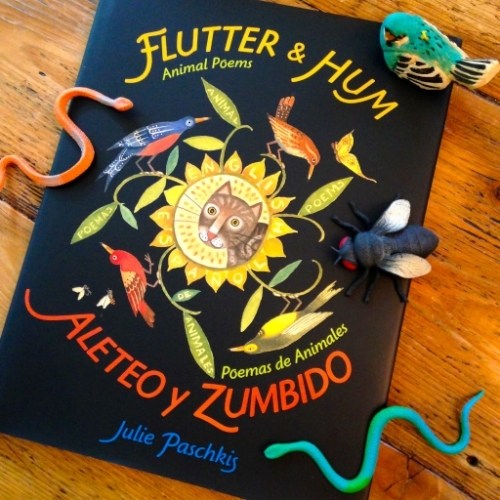
Several years ago, in order to illustrate Monica Brown’s Pablo Neruda: Poet of the People (Henry Holt, 2011), Julie Paschkis immersed herself in Neruda’s poetry and took Spanish language classes.
She fell in love with Spanish, its sounds and structure. Already a lover of words, she found these new words both interesting and fascinating, so much so, that she incorporated them in her paintings to stunning effect. She had created her own brand of visual poetry inspired by Neruda’s words.
Her love affair with the language didn’t end with that book. As one thing can sometimes beautifully lead to another, Julie discovered that her unfamiliarity with Spanish freed her to write poetry. The fourteen free verse animal poems in Flutter & Hum/Aleteo y Zumbido (Henry Holt, 2015) were first written in Spanish, then translated by Julie into English. And as she did with the Neruda book, she added words inspired by the poems to her illustrations.
In this exquisite tapestry of three languages — Spanish, English, and Art — we are treated to Julie’s charming insights and observations of creatures inhabiting land, sea and air, inviting us to appreciate them in new and surprising ways. Did you ever wonder what a turtle might be hiding in her shell?
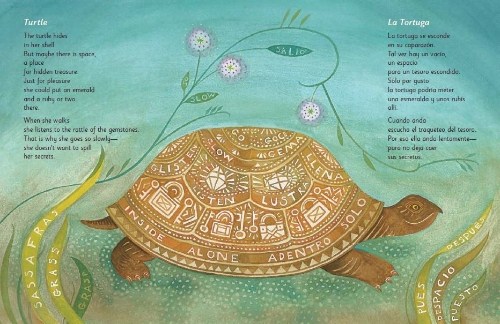
TURTLE
The turtle hides
in her shell.
But maybe there is space,
a place
for hidden treasure.
Just for pleasure
she could put an emerald
and a ruby or two
there.When she walks
she listens to the rattle of the gemstones.
That is why she goes so slowly —
she doesn’t want to spill
her secrets.*
LA TORTUGA
La tortuga se esconde
en su caparazón.
Tal vez hay un vacío,
un espacio
para un tesoro escondido.
Sólo por gusto
la tortuga podría meter
una esmeralda y unos rubís
allí.Cuando anda
escucha el traqueteo del tesoro.
Por eso ella anda lentamente —
para no deja caer
sus secretos.
And the snake? He writes “a slippery poem/with his body . . . He only knows one letter: ssssssssss.” There’s also a whale that dances “In a dazzle of bubbles.” Sheer delight!
The poems vary in mood from playful (a dog’s wagging tail “fans wild happiness/into the wild world”) to peaceful and evocative (“Out of the darkness/an owl hoots./An echo./The night train/is leaving”) to ethereal (“I am a fish in the sea of dreams”).
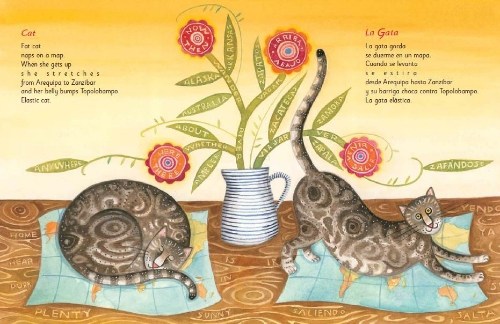
I really love the CAT:
Fat cat
naps on a map.
When she gets up
s h e s t r e t c h e s
from Arequipa to Zanzibar
and her belly bumps Topolobampo.
Elastic cat.*
LA GATA
La gata gorda
se duerme en un mapa.
Cuando se levanta
s e e s t i r a
desde Arequipa hasta Zanzibar
y su barriga choca contra Topolobampo.
La gata elástica.
Isn’t ‘Topolobampo’ the best word ever? Even if we didn’t know it’s a city in Mexico, we get a good sense of how the cat’s moving in that winsome alliterative line, so much fun to read aloud. Flutter and Hum truly celebrates words, languages, and instinctual creative expression. It certainly contributes to our appreciation of how and where poems might emerge, and it’s fun to imagine Julie playing with both Spanish and English and exploring some of the magical places in between.
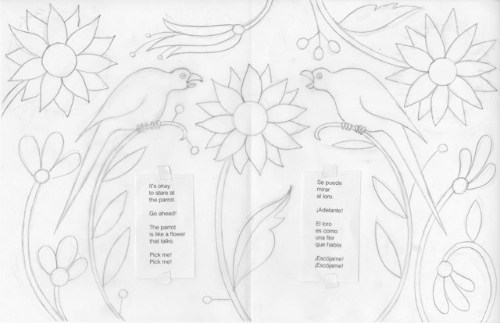

As someone who loves hand lettering, I fairly swooned over Julie’s gorgeous paintings. As words slither on long blades of grass, swirl in the ripples of pond water, ride atop the backs of crows (“crass/brash,” “craven/crooked,” “brujo/brusco”), float in clouds, adorn both halves of a juicy strawberry (“fresh, blush, ripe, giddy, gozo, julio, frivolo”), and stream in dark ocean waves (“nightfall, fill, flow, flung, luna, lustra, bunco, oscuro”), we hear these juicy words spark and sing, bask in their collective serenade, feel the heart quicken. Her careful choice of words, as well as how they are paired or juxtaposed, creates a new energy, another poetic revelation.
Readers will also enjoy the little touches of humor: the parrot is “cheery, cheeky, beaky,” the whale, “buoyant”/”oh boy,” and that irresistible cat, “now/then,” “here/there.” Surprise gifts in the fine details, a veritable feast of words. Perfecto!
I know you’ll enjoy hearing more from Julie herself, and we thank her for visiting today, and for creating this treasure of a book. Perhaps the turtle should stash a copy in her shell? 🙂
* * *
🐢 CHATTING WITH JULIE PASCHKIS 🐋

Why did you decide to write poems about animals? Is there something about the Spanish language that inspired this thematic choice?
I wrote a bunch of poems about a lot of subjects. When I put them together I realized that many of them were about animals or included animal imagery, so I focused on animals as I went forward.
You said in your Author’s Note that your unfamiliarity with Spanish freed you to write poetry. What was your overall process like when beginning a new poem – did you think in terms of certain Spanish words or phrases first, or did you think of images or perhaps emotions you wished to convey?
The poems mostly arose out of individual words. Then I spun ideas around those words. For example when I wrote the poem about the deer I realized that the word ve (he looks) was part of the word venado (deer). And the word vistazo which means glance is such a brittle delicate word – like a deer running away with branches snapping.

Were there any reference materials about either the animals or the Spanish language that were especially helpful?
The Spanish/English dictionary! I would troll through the dictionary on word hunting expeditions.
What did you learn about writing poetry as a result of working simultaneously in both languages during the revision process?
Poetry is about sound and meaning. I think it helps to approach it slowly, and working in both languages definitely slowed me down.
I smiled when I read your words, “I am not a poet,” because to me you’ve always been a brilliant visual poet, who seamlessly incorporates alliterative and rhyming words in your illustrations. What’s your favorite illustration in this book? Could you tell us a little about how you created it?
Thank you! My favorite illustration in the book is the Moth /La Polilla. I kept painting the blues darker and darker and I felt like I was being pulled into that color. For every poem I made lists of related words for the paintings. I had a pantry full of words. But I only used a few of those words in this painting, because I thought the empty spaces made it feel more like night and made the words that I did choose more important.


I love the placement of the giant strawberry that accompanies your poem “Fly/La Mosca” — how the book’s gutter naturally halves the fruit into English and Spanish sides. For the art, did you choose the Spanish or English words first? Any special criteria for word choice?
For each painting I made lists of words in both English and Spanish. The words that illustrate the poems are not translated word for word from side to side – they are just words that I like in both languages. I picked the words for their sound and meaning. I wanted the words in both languages to amplify or riff on the meaning of the poems. I did not know before starting the painting which words I would end up using in the painting or how many. Each word I chose determined the words around it.

What was the best part of working on this project? Does this mean you’ll be creating more poetry books?
I loved playing with language and images together. I have been working on new poems – I don’t know if they will turn into a book or not.
Is there anything else you’d like us to know about the book?
The poems are arranged from morning to night (roughly) so the colors start out soft in the morning, are bright in the middle of the day and end up in the dark night.

What are you working on now?
I am working on the paintings for a book called Magic Spell (which I also wrote). It is about a magician who is a great speller. His name Aziz and he has an assistant Zaza. They need to learn to work together. It will be published by Simon & Schuster and I hope that it will be spellbinding.
*

FLUTTER & HUM/ALETEO Y ZUMBIDO: Animal Poems/Poemas de Animales
written and illustrated by Julie Paschkis
published by Henry Holt BYR, August 2015
Bilingual Poetry Picture Book for ages 4-8, 32 pp.
**Starred Reviews from Publishers Weekly, Kirkus, and The Bulletin**
♥ Don’t miss Julie’s wonderful Flutter and Hum post at Books Around the Table
♥ Check out Julie Danielson’s review at Kirkus
*
📗 SPECIAL BOOK GIVEAWAY 📘
For a chance to win a brand new copy of Flutter and Hum, please leave a comment at this post mentioning your favorite animal no later than midnight (EDT) Wednesday, October 7, 2015. You may also enter by sending an email with ‘JULIE’ in the subject line to: readermail (at) jamakimrattigan (dot) com. Giveaway open to residents of the U.S. and Canada only, please. Winner will be announced next Friday. Good Luck!
* * *
THE JUMPING OFF LIBRARY SHELVES GIVEAWAY WINNER
IS
BRIDGET R. WILSON!!
CONGRATULATIONS, BRIDGET!
Please send me your snail mail address so we can get the book out to you lickety split!
Thanks, everyone, for all the great comments. Loved hearing about all your childhood libraries!!
* * *
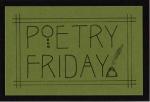 Heidi Mordhorst is hosting today’s Roundup at My Juicy Little Universe. Flutter by and check out the full menu of poetic goodness being served up in the blogosphere this week.
Heidi Mordhorst is hosting today’s Roundup at My Juicy Little Universe. Flutter by and check out the full menu of poetic goodness being served up in the blogosphere this week.
————————————————————–
*Interior spreads from Flutter and Hum posted by permission of the publisher, text and illustrations copyright © 2015 Julie Paschkis, published by Henry Holt. All rights reserved.
*Copyright © 2015 Jama Rattigan of Jama’s Alphabet Soup. All rights reserved.

I wanted to cry when this book came in the mail and when I sat poring over its gorgeous pages. It is simply exquisite, as is this post. Thank you both for making the world a kinder, more beautiful place. I am grateful! xo
LikeLike
I know just what you mean, Amy. I’m still savoring each and every page — the word exquisite doesn’t seem to be enough sometimes. I do hope she publishes more poetry books! For now, I’m looking forward to reading about Aziz and Zaza :).
LikeLike
It looks and sounds stunning. I love that juicy strawberry picture. Spanish in poetry is the ultimate delicacy. Thanks Jama
LikeLike
Definitely a stunning book. That strawberry is beautiful and I love the way the words float on its surface. 🙂
LikeLiked by 1 person
So, so beautiful! What a celebration of words — and of life!! More poetry books please, Julie! Thank you, Jama. xo
LikeLike
Yes, more poetry books! Wonderful how one can appreciate words anew when you see them hand drawn and cavorting with other wordy friends. 🙂
LikeLike
Such a gorgeous book! I can’t wait to read it. My favorite animal is a Boston Terrier dog.
LikeLike
Ruff ruff! You’re the first to mention your favorite animal. Thanks, Bridget – and Congratulations again! 🙂
LikeLike
This book is transformative – a beautiful ballet of words and art. I want to hug it!
LikeLike
Oh – and platypus. 😉
LikeLike
Yes — “Ballet” is a wonderful way to describe it. Didn’t know you were fond of platypuses :)!
LikeLiked by 1 person
Such a beautiful book!
LikeLike
Yes yes!
LikeLike
Beautiful artwork! It’s wonderful that a key turned, opening the door to writing poetry for Julie. What a happy circumstance.
LikeLike
Such an unexpected gift! Lucky for us too :).
LikeLike
Gorgeous, gorgeous, gorgeous, in every way. Wonderful to hear Julie talk about her process. Thank you, Jama, and congratulations, Julie! (Oh, as a map-lover, I especially love “Cat”!)
LikeLike
Gorgeous and exquisite and beautiful and then some. Hope you get to see this book soon, Linda. The cat on the map was so delightfully surprising, as our first thought would usually be “cat on a mat.” 🙂
LikeLike
Jama – Thank you so much for inviting me to be in your Soup. I appreciate the depth that you go into on your blog, and I am honored to be part of it.
Julie
LikeLike
Thank YOU, Julie — for creating this amazing book and for visiting today. You always add such good flavor to the SOUP!
LikeLike
Wow–I am in awe that Julie has written such gorgeous poems in another language–and the way these words that were new to her inspired her. And the art! Each picture is like a bonus poem.
LikeLike
Yes, so many layers of beauty and wonderment in this book. Love the idea of letting the sound and “feel” of words inspire your thinking.
LikeLike
We have a plump-faced little tesora in our lives now for whom I am scouring booklists for the best Spanish-English picture books. Always glad to see more for when she’s a tiny bit older. This is really, REALLY beautiful.
LikeLike
Oh, a plump-faced tesora :)! How lucky she is to have you already lining up good bilingual books to read.
LikeLike
What an absolutely gorgeous work of art! I adore these poems and paintings. Thank you so much for posting this!!
LikeLike
Truly gorgeous work! I’m in constant awe of Julie’s work. What will she do next?
LikeLike
Wow! I just asked my library to order this visual delight. Thanks for sharing.
LikeLike
Yay!
LikeLike
Topolobampo is the best word ever! And Flutter and Hum ranks up there with the best titles ever. Thanks for introducing me to this book! Favorite animal…it depends on the day. Today…cat. Meow!
LikeLike
Meow to you, Penny! Glad to hear you like Topolobampo too. It *IS* a wonderful, wonderful word!
LikeLiked by 1 person
Jama, Thanks for a beautifully moving post. WOW! How delicious to see the art and the poetry from FLUTTER AND HUM.
My favorite animal
comes from the sea
the rolly-polly
manatee–
tee-hee.
LikeLike
Love your rhyme, Joy. Manatees everywhere are likely smiling today!
LikeLike
I loved this book, reviewed it last week, Jama, but love all that you brought into your review. It made me love the book even more. Thanks for the interview with Julie too. The process she used seems like a love affair with both animals and words. Thank you!
LikeLike
And of course I forgot my favorite animal, which is the giraffe. I hope that someday I’ll get to see them in the wild!
LikeLike
There is so much to love about this book, and you’re right — a love affair with animals and words is a wonderful way to describe her process.
Nice to know you like giraffes! Sounds like you need to sign up for an African safari. 🙂
LikeLike
Her style thrills the word lover in me, and *the color* is scrumptious. I love the tortugas spread — in New Mexico there is a town named Tortugas and they have turtle races every year. 🙂 Hmmm. Did she write about chickens?! xoxo Wonderful post, Jama!
LikeLike
She didn’t write about chickens in this book, but she just did P. Zonka Lays an Egg, an entire book about chickens! That one’s gorgeous too. 🙂
LikeLike
I am so pleased to see this book featured on your blog, Jama. I think it is wonderful, too. The fact that Julie P. hears the word “vistazo” as something brittle and delicate says everything about why her poetry works so well. She is hearing another level of meaning! Glad to see that Flutter and Hum has been nominated for a Cybil (thanks to Linda Baie!) Hope it gets some real attention from people beginning to have Mock Caldecott conversations.
LikeLike
Yes, I saw that Linda had nominated it :)! She has long proven her artist’s eye, now we see she has a poet’s ear. Amazing work which I hope, like you, gets some Caldecott buzz.
LikeLike
Ok I am seriously in love with that picture of the cat and the squirrel one as well- so stunning, I might have to order that book!!! Great post!
LikeLike
Yes you need to order it. Such a treasure!!
LikeLiked by 1 person
[Kindly forgive your host’s lateness: converging appointments including a rather loud 13yo boy’s birthday party interfered!]
Oh…oh….oh! My new favorite book. I have always loved Julie’s artwork since I discovered it in Janet Wong’s collection Night Garden–it is so whimsically decorated and decorative, “doodled” but in a much more sophisticated way than that word usually allows, and therefore somehow both highfalutin’ly fine art AND thoroughly accessible.
Now as though to make me personally swoon she has added letters and words and languages…I can barely wait to hold it. Thank you, Jama, for this introduction!
LikeLike
You’re in for such a big treat with this book — have you seen her Pablo Neruda book from before (also GORGEOUS with words in the illustrations).
LikeLike
From a lover of words, I am inspired. The pictures won’t enlarge for me, so I am on a quest to see this book up close and personal. I always think of my grandchildren and wonder about their reactions to certain books. A favorite animal has to be a dog for me–always have one around. Thank you again, Jama, for inspiration.
LikeLike
Yes, you must see the book in person to fully appreciate everything about it. Yay for dogs!!
LikeLike
Oh wow! I get introduced to so many interesting poets and books here, Jama. And today’s bonus is this words incorporated into the illustrations. I don’t know if I’ve ever seen that before. I’d love to read this book with my grand-kids. I can just imagine the discussions we’d have!
LikeLike
Those words in the illustrations are simply magical!
LikeLike
The words have become art and it’s just beautiful. Congratulations to Julie! (I love the way the tortoise’s feelings are embedded into the words on its shell pattern.) My favorite animal *today* is the dog, because our two dogs made me laugh on a rainy day.
LikeLike
There are wonderful surprises to be found when studying the words in the illustrations. Julie had a lot of fun with this book! 🙂
LikeLike
This sentence captures the perfection of this book: “…this exquisite tapestry of three languages — Spanish, English, and Art”
LikeLike
The more I like a book, the harder it is to find the words to do it justice. 🙂
LikeLike
I thought the same thing Mary Lee just said! :0) I’ve been anticipating this book and have it on order and on its way. Thank you both for this peek into Julie’s creative process – I’ve been a fan a long time! Swoon swoon.
(And I’m intrigued by Mr. Brick Man in the author photo…??)
LikeLike
Yes, isn’t Mr. Brick Man great? I suppose that’s what comes of having two artists in the family. 🙂
You are going to love this book, Robyn! Prepare to swoon big time.
LikeLike
Wow. This is absolutely gorgeous. Can’t wait to get my hands on it.
LikeLike
You’re in for such a treat!
LikeLike
What a wonderful review and interview, Jama and Julie, and what a GORGEOUS book! Thanks to you both! I so enjoyed reading about Julie’s process of bringing Flutter and Hum to life– the attention paid to the sound of words as much as the meaning, and how Julie manages to pry out the animals secrets. Love that ruby-toting turtle! Can I request a poem about a sloth, please?
LikeLike
I imagine there aren’t many poems written about sloths. Interesting choice, Michelle. Glad you enjoyed the post. You must see this book ASAP if you haven’t already.
LikeLike
Another must-have book to add to my list, Jama!
LikeLike
Absolutely!!
LikeLike
So much to like here–art, poetry, process! Of course, la gata is my favorite!
LikeLiked by 1 person
La Gata is absolutely adorable! Topolobampo makes me want to hug myself . . .
LikeLike
What a stunning book! I want to dive into that final spread with the fish. Thank you, Jama, for sharing so much of it and the interview with Julie!
LikeLike
She has a similar ocean spread in the Pablo Neruda book. Words swimming, flowing, drifting . . . gorgeous!
LikeLike
What could be better than Neruda poetry and your amazing art. Ahora Estoy visitando Guatemala estudiando espanol y ayudando constuir escuelas por pueblos Mayan. I was just telling a friend how desperately we need children’s books written in spanish and here you are!! I love love love it. Thank you for this piece of art.
LikeLiked by 1 person
Glad you enjoyed this post. I’ve just interviewed Jorge Argueta about a brand new Spanish-English picture book:
LikeLike
I would like to say that mine is a elephant as my favorite.
-thefiggtree@yahoo.com
LikeLike
I love elephants too!
LikeLike
Great review and interview! My favorite animal is a fox. 🙂
LikeLiked by 1 person
Fuzzy the Fox (one of our yard pets) is thrilled to hear this. Do you see foxes in your neighborhood?
LikeLike
I thought I had commented earlier, but I don’t see it so I will repeat that Julie’s work is stunning. I LOVE her Pablo Neruda book. Gorgeous. The Topolobampo reference in the poem made me smile as it reminds of Chicago – a beloved and well known restaurant (by Rick B) next to Frontera Grill.
LikeLike
I LOVE LOVE her Pablo Neruda book too! I think she has a print of one of the illustrations for sale in her Julie Paprika shop.
I think I’ve heard of the Topolobampo restaurant — such a fabulous name — I’d want to eat there just for the name.
LikeLike